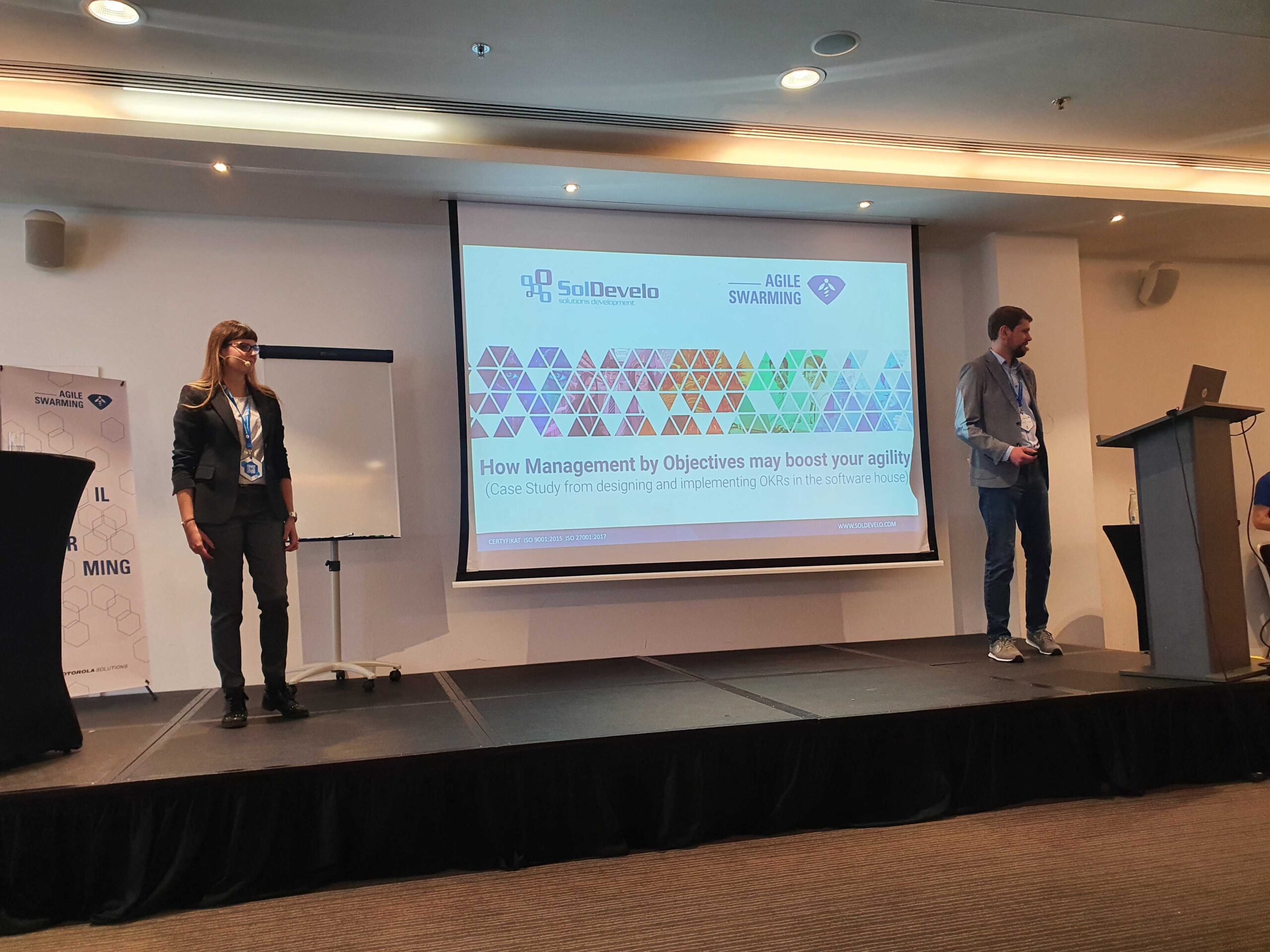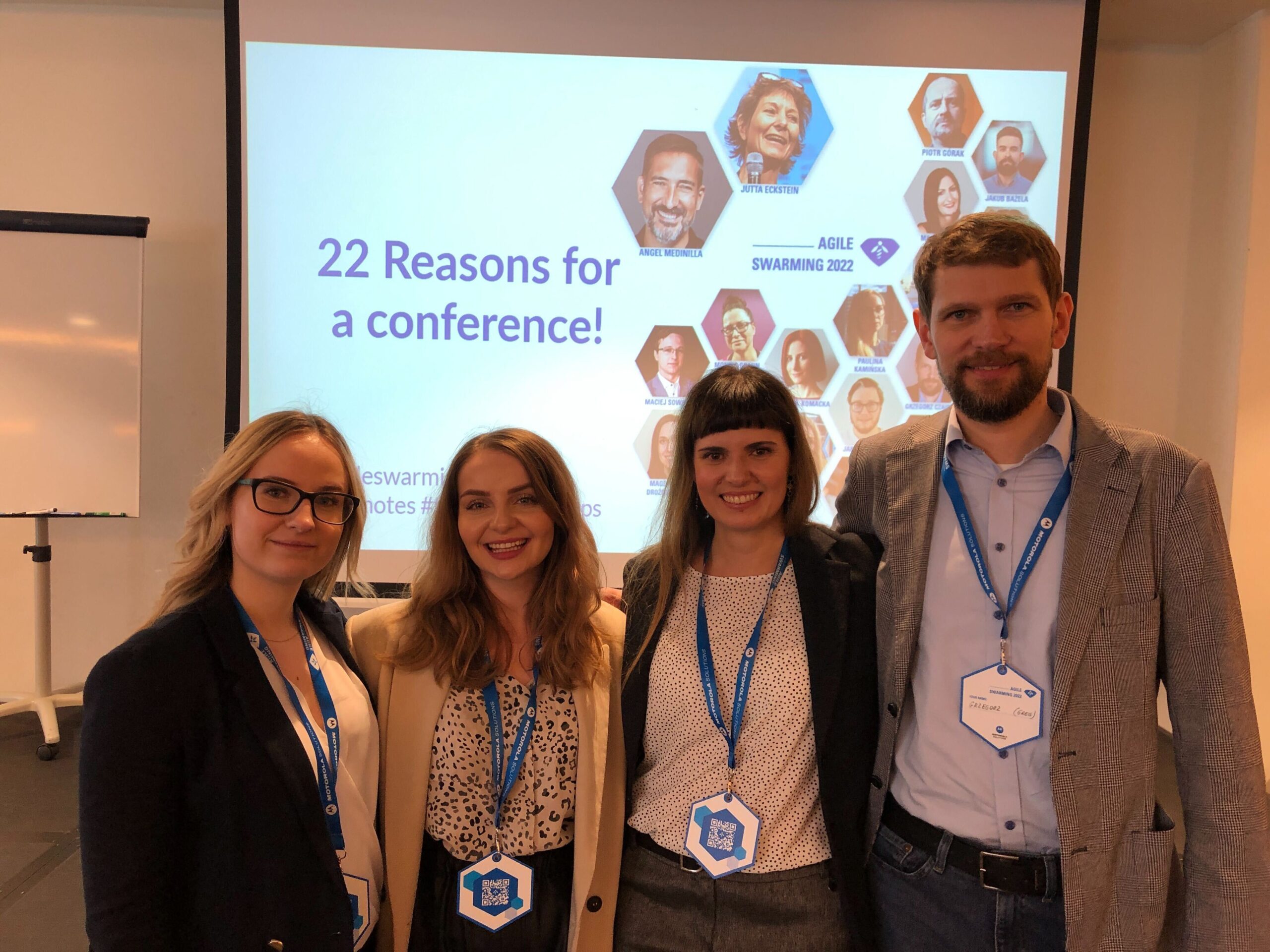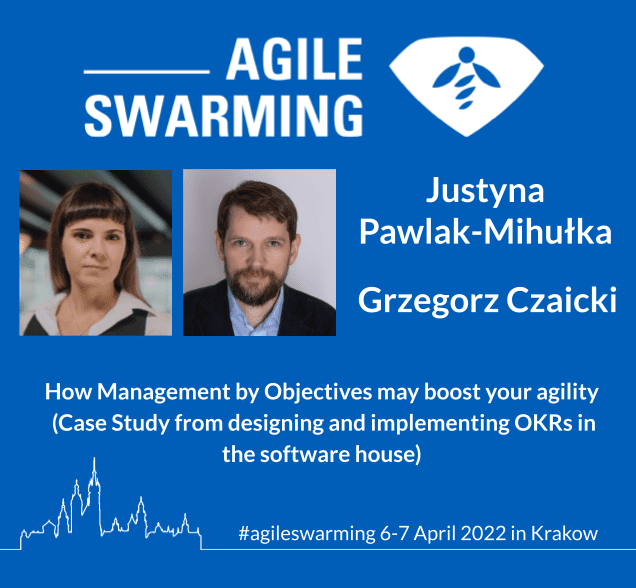(Case Study from designing and implementing OKRs in the software house)
SolDevelo is the software house with around 60 employees. Our organization’s structure is flat, however, we’ve been growing and changing for some time now. Our company is in the middle of scaling up. If a company wants to scale up, it needs to act more quickly and make decisions faster. So it is important that everybody in the company is aware of the vision and goals. There must be a link between day-to-day work and strategic goals, to make sure that we are on the same page. The gap between the daily tasks of each employee and the company’s goals may directly impact employees’ motivation, purpose, effectiveness, and attrition.
This may be the perfect time to implement the Management by Objectives model in the organization.
Management by Objectives
As Scrum Masters we are able to converse Agile techniques and practices, as well as the understanding of the product vision, into the organization level. We can facilitate and coordinate the process, and help to focus on the goals and priorities.
From the very beginning we’ve assumed that this initiative is possible only if we manage to work together with the whole management. Inclusive approach was one of the fundamentals and, looking at the history of our company, it was actually the game changer. With two Scrum Masters as facilitators, board members, all project managers, team leaders, and head of HR department, we’ve formed a team with one goal: how to move forward, how to make the next step and put more details and understanding to our business goal, in order to scale up. As Agile enthusiasts, we prefered interactions, direct communication, and full transparency.
When we started the discussion on the goals, we quickly discovered that our previous Mission and Vision had been formulated in a too general way, not really meaningful and not stealing the hearts of our employees. Actually, we found out that they had been published, but not properly communicated – therefore, we’ve decided to take a step back and reformulate our Mission. In result, we gained the possibility to work together in our big team for the very first time, creating the context for the strategy.
Eventually, we’d started to build real engagement and accountability within the middle management. Those discussions were really open, showing different perspectives of all the parties involved. But it was not the end: we organized a town hall for the whole organization, announced the new Mission and asked for feedback. We’ve invited every single employee to discussion, sharing concerns, questions, etc. We’ve worked it out and adjusted the Mission statement.
The next important step was inspection of previous organizational initiatives and projects. As some of them weren’t successful, we found out that our approach in the OKR project must be different. Based on the managers’ interviews, we’ve decided to put more emphasis on engagement, transparency and open communication.

OKRs implementation
The series of workshops was set up. That was the first moment when the middle management team and board members were working together, discussing their perspectives, sharing their thoughts and crafting common solutions. As Scrum Masters, we were responsible for facilitating the meetings, designing the workshops, and helping to understand the OKRs implementation process.
However, what should be mentioned here, is that at this point no one in our team had had any practical experience with OKRs. Even theory was known only to some extent. So we’ve started to learn, read a lot of articles, blogs, books. We’ve participated in an external training and in parallel we’ve started to share that knowledge with people – of course, our wide management team was the first group to be trained. We’ve learned together during a series of workshops, looking for the core that would be helpful in our situation.
Having already agreed on strategic areas we should focus on, and on the other hand also having some imagination about the method, we’ve started to shape our goals – to make them more concrete and specific. This was a unique experience and a huge step forward for all of us. Even though we’ve agreed on the strategic areas quite easily before, now, discussing the details of the expected outcomes, shaping the goals and assigning some numbers – it was a long journey and only by then we’ve come to a deep common understanding of what we are talking about. We’ve been using tools that are well-known to us – like MIRO board, working in pairs and in groups. Working intensively, we’ve adjusted our KRs again and again. It was like estimations in Scrum – we’ve negotiated KRs, numbers, values and redesigned the whole objective again.
The energy within the team was enormous – the true ownership raised. At the end, we checked how confident we are about the formulated goals and after full confirmation we communicated everything to the whole organization. Again, we invited everyone to participate – ask thoughtful questions, point-out weaknesses and risks. The method we’ve chosen assumes full transparency and in our case it is like plus five points to credibility.
During the process of designing the OKRs implementation we set up a few rules. Here are the most crucial ones:
- Team OKRs are timeboxed to quarters.
- During the Pilot in Q1 we wanted to invite 2-3 teams.
- Only one OKR for the team.
- We wanted diverse teams: project teams and cross-teams.
- Negotiable model of defining OKRs (button-up and top-down).
The tracking tool in Google Sheets was created and designed by ourselves. The tool is interactive, fulfilled by OKRs teams’ leaders and transparent for everybody in the company.

OKRs in practice
As you probably know the words of Eisenhower – “planning is everything, plan is nothing” – even though we’ve assumed 2-3 teams in the pilot, finally we’ve ended up with 6 teams. The level of energy, enthusiasm and optimism was so high that we felt we could move the mountains. We’ve tried with one service project team, one internal product team (both working in Scrum) and 4 cross-teams, mainly formed from our group of managers and leaders. Was it a good direction? It’s hard to say.
At the end of the pilot we ran a retrospective and collected plenty of remarks. The main conclusions are the following:
- Engagement of all participants, also those people from our teams that joined during Q1, as within some teams we tried to invite our employees. This approach proved to be engaging not only at the beginning, when it was quite easy, new, potentially interesting and so on.
- We’ve managed to ensure the clear link between our teams and the strategy of the organization. The need of purpose, sense of sense – those are fundamental human needs.
- Feedback loop was really quick. We were able to redefine some KRs during the Q1, as we had cyclic status meetings in our team. Small teams turned out to be much more agile and effective, and at the same time the whole management, and in fact the whole company had constant insight into progress.
- Our tool, we believe, was well-designed. At the beginning we were complaining about the visibility of the progress and started to think how to improve the tool. However, eventually we came to the conclusion that the tool actually uncovered the weakness of some key results.
- One of our discoveries was the fact that defining OKRs, especially for the first time, is a process that requires mindfulness and time.
- The significance of focus – we worked in those 6 teams (some of us joined more than one team), and in parallel we had our daily activities. The importance of focus and proper prioritization became so visible that one can think – were some strategic processes in the past so slow because of the daily tasks?
- Last but not least is the plan. Within most of the teams we’ve been a little bit naive, thinking only about the goals and acting ad hoc, without a comprehensive plan. It resulted in quite significant intensivity in the last 2-3 weeks.
To summarize what is to be noticed, we still had a high level of energy and engagement within the people and also the board allowed us to continue the initiative. We’ve touched so many important topics, and what can be observed, those topics are present also in our other talks, discussions with clients, within our teams. The overall consciousness is extremely high – now we can say that our people really understand what matters! Within many teams things started to change, people are more proactive and the potential we can see is beyond our imagination. Saying that, we are aware of how important in all of this is transparency and communication that invite all employees to discussion and participation. If people feel they can have an impact, thay are more likely to take the initiative.
Role of Scrum Masters
The conclusion of this article should be that SCRUM MASTERS should participate in organizational design. To contribute to business process change, because they have knowledge, experience, and they know the tools, as well as techniques that can facilitate the process of change.
To sum up our OKRs implementation process, we strongly recommend Management By Objectives, as it may upgrade Agility in the company. Employees are able to see the link between their daily tasks and the company’s strategic goals. MBO directs impact on the purpose and meaning of the work. We noticed that people are willing to act as the owners. The improvement of transparency and trust is visible. What is more, employees’ engagement and integrity are raised on each company level. The awareness of the company’s vision and strategic goals impacts on the fast change and people are able to focus on priorities.
The OKRs implementation has boosted the Agility in our company – we adapt more quickly thanks to empiricism, inspection and adaptation.
Authors: Justyna Mihulka (Scrum Master) and Grzegorz Czaicki (Scrum Master).












